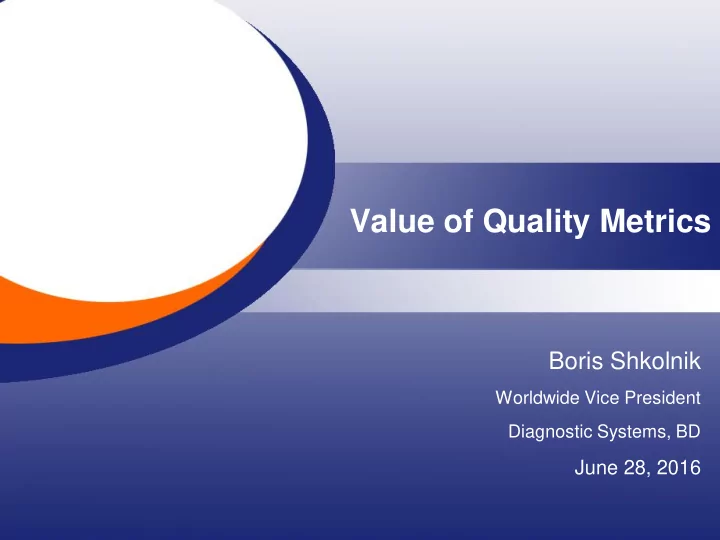

Value of Quality Metrics Boris Shkolnik Worldwide Vice President Diagnostic Systems, BD June 28, 2016
Background • 8 Business Units • 74 Manufacturing plants worldwide • 50+ Distribution Centers • 20+ design centers • Global product presence • ~45k Associates worldwide • Billions finished medical devices and IVDs produced and distributed annually • Enormous volume of data 2
Key Reasons for Initiating a Quality Metrics Process • Gather, Consolidate, Analyze and Interpret complex and large volume of relevant quality data • Enable timely identification of quality issues • Provide unbiased pathways for management escalation • Enable appropriate initiation of corrective actions • Provide management with information for resource allocation • Timely assessment of risk and need for field corrective actions • Influence organizational focus, culture and behaviors – create environment of accountability 3
Types of Metrics Tracked • Customer Satisfaction – Customer Complaints • Number of complaints received monthly • Normalized complaint rate – Could be normalized over units sold, installed instruments, tests per instrument, cycle count …. – Complaint investigation process performance • Customer complaint turn around time (initiation to closure) • % of complaints over 60/90 days • Oldest complaint open – Reliability • Mean Time Between Failures • Service Repair Effectiveness • On time Maintenance 4
Types of Metrics Tracked • Manufacturing Process Performance – Quality Yield • % of Batches/Instruments produced without non-conformances – Number of non-conformances generated – % Non-conformances open > 30/60 days – Number of deviations initiated – % Deviations open > 30/60/90 days • Calibration – % Calibration on time – % OOT – % OOT with product impact 5
Types of Quality Metrics Tracked • Quality System Performance – Training – CAPAs • % on time Training • CAPAs % on Time Completion – Field Actions • CAPA Effectiveness • Average days open • Number Risk Assessments Initiated – Internal Audit • Risk Assessments open > 30 days • Schedule Compliance • Number of Field Actions Initiated • Time Observations Closure – Supplier Performance – Adverse Event Reporting • Supplier Audit Schedule • Number of Adverse Events Reported Compliance • % Reported on Time – Process Validation • Process Validation Schedule Compliance 6
How Metrics are Reported • Data is organized by key product lines, manufacturing plants and in line with business and department organizational structure • Goals are established based on historical or desired performance • Frequency of reporting is predefined based on types of data tracked: – Most monthly, some quarterly, weekly or bi-weekly • Separate reports are generated for complex data – Complaints, CAPA, Non-Conformances, Internal and Supplier Audit 7
How Metrics are Reported • Metrics are structured with increasing granularity and timing at lower levels to enable appropriate visibility, accuracy and support timely decisions Corporate Unit Plant Product A Received CPM Product A CPM Rate (G,Y,R) Product B CPS Product B Received Complaints CPS Product B Trend % > 30/60/90 Days (A) % > 30/60/90 Days % > 30/60/90 Days (B) TAT (G,Y,R) Oldest Open (A) Oldest Open Oldest Open (B) Frequency Quarterly Monthly Weekly 8
Examples of Quality Goals and Report Structure Alert Action 12 Month Scorecard Metrics May 2016 Apr 2016 Mar 2016 Goal FY15 - Q3 FY15 - Q4 FY16 - Q1 FY16 - Q2 Limit Level Average BDDS Overall Calibrations (% Overdue) <6% >7% 1% 0% 2% 6%-7% 3% 2% 1% 2% N/A 2 4 3 <30 Days ≥30 Days 6 3 36 3 N/A Calibrations (Out of Tolerance) > 30 days N/A 100% 84% 100% ≥95% N/A <95% N/A N/A 92% 100% N/A CAPA (% Effectiveness) 3.4% 4.9% 4.6% <3.0% >5.0% 3.4% 0.7% 3.4% 4.6% 2.6% CAPA (% Overdue) 3.0-5.0% 163 147 159 N/A N/A 145 159 N/A CAPA (Average Days Open) <181 181-364 >364 39 36 34 37 43 32 34 N/A Complaints (Average Days Open) <46 46-59 >59 44 40 33 43 52 47 33 46 Complaints (Average Days to Close) <46 46-59 >59 6.1 6.5 5.8 5.8 6.7 6.1 5.8 6.0 Complaints per Million (CPM) <7.0 7.0-7.8 >7.8 0.0234 0.0252 0.0288 0.0224 0.0227 0.0227 0.0288 0.0207 Compleints per System (CPS) <0.0248 0.0248-0.0264 >0.0264 <11% >20% Deviations (% Overdue) 2% 1% 2% 11%-20% 3% 6% 3% 2% 3% Deviations (Average Days to Closure) 69 65 73 <91 91-180 >180 46 50 52 73 63 N/A N/A 88% >95% <80% 96% 100% 100% 88% N/A Internal Audits (Compliance to Schedule) 80%-95% 22% 28% 17% <10% >19% 13% 4% 0% 17% 10% Internal Audits NC Aging >6 months) 10%-19% 11% 10% 12% 14% 7% 5% 12% 11% %QN over 60 days <10% 10% - 15% >15% 98.7% 98.7% 98.5% 97.4% 97.0% 97.0% 98.5% 97.7% RTFT >96.3 95.3-96.3 <95.5 99% 99% 99% ≥95% <95% 98% 98% 98% 99% 99% Training (% Compliance) N/A N/A N/A 94% >89% <51% 98% 97% 85% 94% N/A Validations (% Compliance to Schedule) 51%-89% 87% 87% 88% ≥90% <80% N/A N/A N/A 88% N/A PM Compliance (Completion %) 80% - 90% 46% 100% 89% ≥90% <80% N/A N/A N/A 0% N/A 80% - 90% PM Compliance (On-time %) 11% 11% N/A TBD TBD TBD N/A N/A N/A N/A N/A Infantile Failure Rate * Simulated data 9
Quality Metrics Implementation Process • Quality metrics reporting process is documented in the SOP • Goals are formally established based on statistical analysis of historical performance or desired results • Goals are reviewed as needed and at a minimum on annual basis • Goals are formally approved and records retained • Calculation method is determined and documented • Spreadsheets used to collect and interpret information are validated and controlled • Designated individuals are responsible for gathering, compiling and reporting metrics • Minimum distribution list is established • Reporting frequency is defined in the SOP • Response to underperforming measures is defined in the SOP (Escalation to MR, Risk Assessment Initiation triggers, CAPA, etc…) 10
Recommend
More recommend